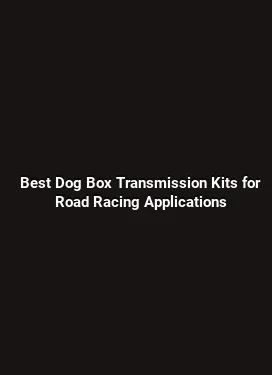How to Install Automatic Transmission Cooler for Heavy Track Use
Track days and endurance sessions place significant demands on a vehicle’s transmission. High ambient temperatures, sustained power delivery, and aggressive shifting can all lead to transmission overheating, which in turn affects fluid viscosity, shift quality, and overall reliability. An appropriately sized and correctly installed automatic transmission cooler helps maintain optimal operating temperatures, preserve transmission fluid integrity, and extend component life. The following sections walk through the considerations, sizing, mounting, plumbing, installation steps, and practical maintenance routines needed to equip a vehicle for heavy track use.
Understanding the purpose and sizing considerations

At its core, an automatic transmission cooler removes heat from transmission fluid as it circulates through the system. The cooler is typically a compact heat exchanger placed in front of the radiator, behind the grille, or integrated into the cooling circuit with the radiator. For track applications, the cooler must handle higher thermal loads than stock setups. Sizing involves assessing vehicle power, torque, gearing, cooling capacity of the existing system, and ambient temperature conditions. Larger engines, higher track speeds, and heavier cars demand greater cooling capacity. A common approach is to select a cooler with a surface area ample enough to dissipate the expected heat load across a wide range of operating conditions, including hot summer sessions and long-duration drives.
Key factors influencing choice include: fluid capacity, line routing, pressure ratings, and compatibility with existing transmission pan drain plugs or thermostatic integration. Efficient cooling also depends on ensuring adequate flow through the cooler, which means considering pump efficiency, filter placement, and any potential flow restrictions introduced by fittings or adapters. In practice, matching the cooler’s capacity to the transmission’s heat rejection profile is more critical than simply installing the largest unit available.
Component selection and compatibility
There are several common cooler configurations encountered on performance builds. The most frequent options are an air-to-fluid cooler mounted in front of the radiator or a stacked plate cooler positioned for maximum heat exchange. For heavy track use, a robust cooler with a corrosion-resistant core, durable fittings, and reliable clamps is essential. It is important to verify compatibility with the transmission model, as some units are designed for specific transaxle configurations or require modifications to mounting points.
In addition to the cooler core, attention should be given to auxiliary components: high-temperature hoses rated for the expected operating pressures, compatible clamps, and a thermostatic valve or fan-assisted module if radiator integration is desired. Some systems incorporate a thermostat that prevents overly cold fluid during short trips, ensuring the cooler only engages when heat buildup warrants it. Consider whether the track routine will involve long idle periods, as heat soak can still occur after a hot session even with a cooler in place.
Mounting hardware and mounting location considerations

Mounting location impacts cooling efficiency and reliability. Front-mounted coolers benefit from maximum airflow, but consider debris, drag, and potential impact risks. A frame-mounted bracket or a dedicated bumper aperture can provide secure mounting without interfering with other front-end components. If space is limited, some installations use an under-radiator shield or a dedicated skid plate to protect lines and fittings while preserving airflow. When selecting mounting hardware, choose corrosion-resistant materials and verify that lines have the correct bend radii to prevent kinking or excessive vibration.
Cooling circuit integration and plumbing
Designing the cooling circuit involves routing transmission fluid from the transmission outlet to the cooler and back to the inlet. A typical path includes an inlet line from the transmission, a return line to the transmission, and a bypass route when the cooler is not in use. Some setups incorporate a sandwich plate adapter that bolts between the transmission fluid port and the cooler, simplifying plumbing and reducing the number of potential leak points. If a thermostatic valve is used, the valve should be positioned to allow fluid to circulate through the cooler only after the system reaches the target temperature, reducing unnecessary cooling at lower temperatures.
When routing lines, avoid sharp bends, minimize length to reduce pressure drop, and keep lines away from hot exhaust components. Use heat shields or protective sleeving where lines pass near engine or exhaust heat sources. Quick-connect fittings can speed up serviceability but require proper seals and secure clamping to prevent leaks under vibration. Always check for compatibility with transmission fluid type and ensure that clamps and fittings are rated for the operating pressures typical of the chosen cooler system.
Electrical considerations and control strategies
An electronically controlled fan or an auxiliary electric pump can augment cooling, especially in slow-moving or hot ambient conditions. If an electric fan is used, ensure the control strategy integrates with the vehicle’s cooling system to avoid simultaneous operation that could draw excessive current or create electrical interference. Some installations opt for a simple, always-on fan tied to the vehicle’s battery through a dedicated relay, while more advanced setups use temperature sensors or ECU-driven control to modulate fan speed for optimal performance and efficiency.
Installation steps: a practical, field-ready workflow
Preparing for installation involves gathering tools, securing a clean workspace, and verifying all parts against the chosen cooler kit. Before removing existing components, record measurements and take photos to aid reassembly. The following steps outline a pragmatic approach suitable for track-day readiness without sacrificing reliability.
Step 1: Drain and evaluate transmission fluid. If the fluid appears dark, contaminated, or smells burnt, plan a full or partial fluid change to prevent contaminant introduction into the cooler. Step 2: Mount the cooler. Align the mounting brackets with sturdy points on the chassis or bumper structure. Tighten fasteners to factory-recommended torque while ensuring the cooler remains level and unobstructed by airflow obstructions. Step 3: Route and secure lines. Run lines from the transmission to the cooler, keeping them away from hot surfaces and rotating components. Use protective sleeves or heat shields in high-temperature zones. Step 4: Connect fittings and seal. Use the supplied adapters with appropriate thread sealant or Teflon tape where recommended. Step 5: Integrate temperature control. If a thermostat or fan is included, wire it according to the instructions, ensuring a reliable power supply and proper grounding. Step 6: Purge air and leak test. Once assembled, fill the transmission with the correct fluid, operate through a few warm-up cycles, and then inspect for leaks. Subtle leaks at hose clamps or fittings should be addressed immediately to prevent subsequent failures. Step 7: Bleed the cooling circuit if required. Some systems necessitate any trapped air to be expelled to maintain consistent flow and heat transfer efficiency.
Common installation pitfalls and how to avoid them
One frequent misstep is underestimating the hydraulic flow requirements, resulting in poor cooling performance. Another is routing hoses too close to the engine or exhaust, which can accelerate wear or cause heat-induced deterioration. Ensure that the cooler is sized for the specific vehicle setup, including engine torque curves, track profile, and transmission type. Check that all electrical connections are protected from vibration and moisture, and that mounting hardware remains secure after initial road or track testing. Regular inspection after the first few sessions helps identify potential wear points early.
Operational best practices for track use
Beyond installation, maximizing the life and effectiveness of a transmission cooler involves disciplined maintenance and monitoring. Use a high-quality, heat-stable fluid that matches the vehicle’s specification and the cooler’s compatibility. During track sessions, monitor fluid temperatures if the vehicle provides live data, and be prepared to adjust the pit strategy if temperatures approach the upper limits of normal operating range. Periodically inspect hose ends and clamps for signs of seepage, especially after aggressive track sessions or high-speed/long-duration runs. When feasible, perform a diagnostic check after the track day to assess overall transmission condition and ensure the cooler components remained secure and effective.
Intermittent heat cycling is natural in track environments, but maintaining a robust cooling solution helps prevent thermal degradation of transmission seals and fluid. A well-functioning cooler also reduces the risk of slip, hard shifts, or delayed engagement that can accompany excessive heat. In addition, consider pairing the cooler with upstream air management strategies, such as keeping the under-hood area clean of debris and ensuring adequate radiator airflow to support overall cooling performance.
Maintenance routines and long-term care
To sustain cooling efficiency, implement a routine that includes periodic fluid analysis or color checks, line inspections for cracks or leaks, and mounting integrity checks. Replace hoses and clamps that show signs of wear, cracking, or swelling. If a thermostatic valve is present, test its operation by warming the vehicle and verifying that the valve opens and closes as designed. Many track enthusiasts schedule a post-season inspection to re-evaluate cooler performance after repeated high-heat events and to refresh any components nearing the end of their service life. Keeping a documented maintenance log helps anticipate part replacements and reduces the risk of unexpected failures during future sessions.
During prolonged track use, environmental conditions can influence performance. Heat-soaked radiators or external temperatures can shift the cooling demand. In such cases, refining airflow through the front-end, upgrading airflow-directing components, or selecting a cooler with greater thermal capacity may be warranted. For vehicles operating in extreme heat, a high-capacity cooler paired with an efficient fan system provides a robust safety margin against overheating and allows for more aggressive driving strategies with reduced risk.






